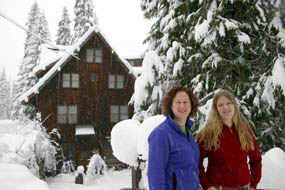|
You are viewing ARCHIVED content published online before January 20, 2025.
Please note that this content is NOT UPDATED, and links may not work. For current information,
visit https://www.nps.gov/aboutus/news/index.htm.

A volunteer group from Seattle, Washington spent the weekend at Oregon Caves doing restoration work and their efforts did more than make the cave cleaner. Their work was essential for obtaining funding for improving and protecting the cave environment. “Without groups like this coming to the monument and donating time, we may not be able to qualify for funding we need to get projects done”, said John Roth, who has been the Resource Specialist at the monument for almost 18 years. He was referring to the requirements for “challenge cost-share” grants, which stipulate that applicants are obliged to contribute a share of the cost to qualify for receiving money for a project. Volunteer work counts toward this contribution. Groups like this are also considered to be partners in the project and this leverages some additional strength when applying for grants. “The more partners you can show are working with you the more likely you will get the grant”, he added. Eleven of the 15 member work crew came from the Cascade Grotto, a Washington State branch of the National Speleological Society. Four other members came from the Oregon Grotto based near Portland, Oregon. The group was coordinated by Hester Mallonée, the Conservation Chair of the Seattle-based grotto club and who has been organizing volunteer groups to come to Oregon Caves for the past four years. “Most of our work we do involves small scale cleaning such as cleaning lint left on formations”, said Hester. The group focused on cleaning two sections of the cave, which will be used as part of a study on cave adapted life later this year. Lint removal is no small task. “Each year, about 50,000 visitors take a tour through Oregon Caves and each of these people leave behind an assortment of things to include lint and hair” said Roger Brandt, who has been overseeing educational programming and cave tours at the monument for ten years. “You can demonstrate this for yourself by standing near a bright light with a dark background and brush back and forth on the shoulder of your shirt or jacket for a couple of seconds. You should see a lot of lint and dust flying around. This is the type of stuff that comes off the clothes of visitors as they walk through the cave and, over the span of a year, the lint from 50,000 people can really add up”. The daunting job of cleaning the cave was voiced by Hester’s daughter, Rosemary, who is currently in the tenth grade. “Seems like every section we clean we find more that needs to be cleaned”, she said also noting that the cleaning has led to a real sense of discovery. “When we cleaned a thick layer of dirt and lint off of one formation, we found some signatures with dates”, she said. “The dates were from the late 1800s and I wonder if anyone even knew they were there”. The group spent the weekend in the upper two floors of historic Oregon Caves chalet, the building used for housing seasonal staff. Staff live in the upper two floors and the visitor center is on the first floor. The group departed on Sunday for home but Hester and her daughter stayed for another two days to continue work. Their stay was extended unexpectedly when snowfall made it dangerous for them to drive down the narrow, curved road from the monument to Cave Junction. “Staying in the historic building is extremely cool”, said Hester, who appeared to be energized by the scenic landscape of snow covered historic buildings and trees near the cave entrance. “We’ll be back again next year”. Hester first became interested in Oregon Caves in 2002 when she painted an illustration of a formation called Paradise Lost. Her painting won the Blue Ribbon Award from the National Speleological Society in 2005. More of her art was featured in the August 2006 issue of the National Speleological Society News. The National Speleological Society (NSS) is an organization formed in 1941 to advance the exploration, conservation, study, and understanding of caves in the United States. The organization is subdivided into individual clubs called grottos, which are located in many communities around the Nation. These clubs carry out cave related conservation projects on behalf of the NSS. These projects include cave mapping, cleaning, scientific study, and the gating of caves to protect the natural environment or hibernating bats. There are many projects that volunteers can work on at Oregon Caves. For more information contact Oregon Caves. |
Last updated: February 28, 2015
